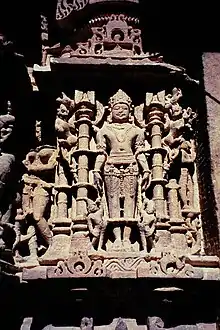Jivantasvami
Jivantasvami images represent the Jain Tirthankara Mahavira (and in some cases other Tirthankaras) as a prince, with a crown and ornaments.[1] The Jina is represented as standing in the kayotsarga pose.[2][3] Jivantasvami images have been used only in the Shvetambara Jain tradition, they are unknown in the Digambara tradition.

Description
The earliest reference to the Jivantasvami images is found in the later commentaries on the Shvetambara Jain Agamas (c.mid 6th century AD onwards), Vasudevahindi of Samghadasagani(c. mid 6th century CE) the Avashyakachurni (c. 625 CE) the Avashyakavritti of Haribhadra Suri(c. 750 CE) and the Trishashtishalakapurushacharita of Hemachandra (c. 1169-72 CE).[3] These mention the existence of Jivantasvami images at Ujjain, Dashapura (Mandsaur), Vidisha, Vitabhayapattana, Puri and Koshala.[4] Mahavira Jain temple, Osian houses three 5.7 feet (1.7 m) Jivantasvami images inside temple. Two of these idols are identical, with one having inscription dated 1044 C.E. that identifies the idol to be of Rishabhanatha.[5][6][7]
According to Hemachandra, the original image was made by god Vidyunmali, carved in sandalwood, during the time Lord Mahavira was still a prince.[8] According to the legend of the queen of Udayana of Vitabhaya worshipped this image. This image was eventually installed at Vidisha, but was eventually lost.[3]
The best known images of Jivantasvami were found in the Akota Hoard, and are widely mentioned examples of the early western Indian school of art.[9] One of them is specifically inscribed as Jivantsvami installed by Nagisvari, which represents early phase of the Gupta style.[10] The images were dug out sometime before June 1951. A University of Baroda professor brought five of them to archaeologist U.P. Shah for examination. U.P. Shat eventually purchased most of the images from local individuals and presented them to M.S. University, which are now in the Baroda Museum. Two Mahavira Jivantasvami idols at Baroda Museum are dateable to 6th century.[3]
Other tirthankaras including Rishabhnath (1st Jina), Sumatinatha (5th Jina), Chandraprabha (8th Jina), Shitalanatha (10th Jina), Shantinath (16th Jina), Munisuvrata (20th Jina) and Parshvanatha (23rd Jina), were also sometimes represented in the form of Jivantasvami.[11][12][13]
Museums
The two famous Jivantasvami images along with the rest of the Akota Hoard bronzes are in the Baroda Museum & Picture Gallery.[2]
References
Citation
- Tiwari 1993, p. 847.
- Shah 1995, p. 15.
- Tiwari 1993, p. 848.
- Shah 1995, p. 16.
- Cort 2010, pp. 163–164.
- Tiwari 1993, p. 849.
- Tiwari 1993, p. 851.
- Shah 1987, p. 35.
- Kramrisch 1962, p. 87.
- Akota Bronzes, Bombay State Board for Historical Records and Ancient Monuments, Archaeological Series. no. 1. Umakant Premanand SHAH, 1959, p. 26-27
- Shah 1987, p. 163.
- Tiwari 1993, p. 850.
- U.P. Shah, Akota Bronze, Bombay, 1959, p 26; Idem 'More Images of Jivantasvami', Jr. Indian Museum xi 1955
Sources
- Cort, John E. (2010). Framing the Jina: Narratives of Icons and Idols in Jain History. Oxford University Press. ISBN 9780199739578.
- Shah, Umakant Premanand (1995). Studies in Jaina Art and Iconography and Allied Subjects in Honour of Dr. U.P. Shah. Abhinav Publications. ISBN 9788170173168.
- Shah, Umakant Premanand (1987), Jaina-rūpa-maṇḍana: Jaina iconography, Abhinav Publications, ISBN 978-81-7017-208-6
- Tiwari, Maruti Nandan (1993). "Jivantasvami images: A study in concept and iconography". Indian History Congress. 54: 847–856. JSTOR 44143087.
- Kramrisch, Stella (1962). "Representing South Asian Art". Artibus Asiae. 25 (1): 87–88. doi:10.2307/3249171. JSTOR 3249171. Retrieved 18 October 2022.